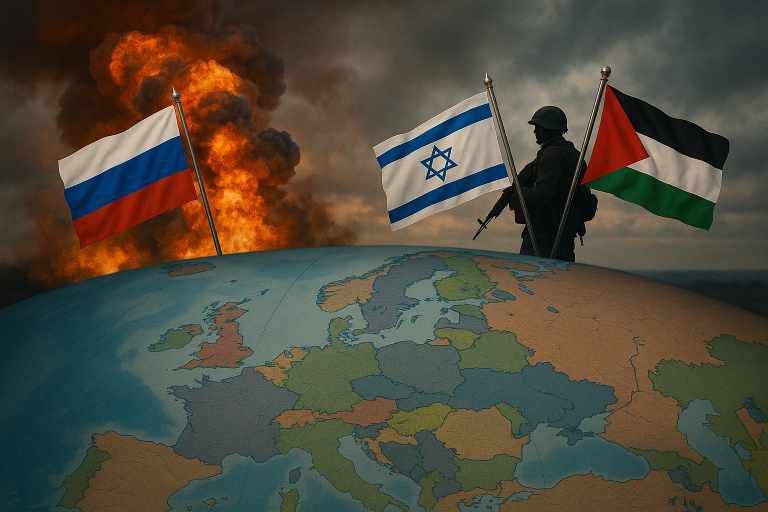The year 2025 finds Europe at a critical geopolitical crossroad. The ongoing Russia-Ukraine war and intensifying Middle East conflicts—ranging from the Gaza crisis to Israel-Iran tensions—are deeply affecting Europe’s economy, politics, and internal security. The continent is facing rising inflation, a new refugee influx, energy instability, and growing social unrest. This article explores the full impact of Russia-Ukraine and Middle East conflicts on Europe and provides a comprehensive outlook on what lies ahead.
Europe’s Energy Landscape: From Dependency to Disruption
Shift Away from Russian Energy
Before the Ukraine war, Europe relied on Russia for over 40% of its natural gas. Following sanctions, Europe has attempted to decouple from Russian energy. This triggered:
- A massive energy crisis in winter 2022-23
- Electricity prices surging by 300% in Germany and Eastern Europe
- Transition to expensive LNG imports from Qatar, the US, and Algeria
Rising Energy Prices and Inflation
By mid-2024, European households were spending over 20% more on heating and fuel than before the war. This energy crunch fueled inflation across multiple sectors:
- Transportation costs soared
- Food supply chains weakened
- Fertilizer and agriculture industries faced production delays
Defense Spending and NATO Realignment
NATO’s Eastern Expansion
The Russia-Ukraine war reignited European fears of territorial vulnerability. NATO responded with:
- Deployment of additional troops in Poland, Latvia, Romania
- Fast-tracked inclusion of Sweden and Finland into NATO
- Greater American military presence in Europe
European Military Budgets Surge
Germany increased its defense budget to over €100 billion, a record since WWII. France, Poland, and the Baltic states followed suit, signaling a shift from post-WWII pacifism to a new militarized Europe.
The Migration & Refugee Challenge
Ukrainian Refugee Wave
Over 8 million Ukrainians have taken refuge in Europe since 2022. Countries like Poland, Germany, and Czechia have been overwhelmed:
- Healthcare and housing systems stretched thin
- Public resentment in urban areas rising
- Far-right parties gaining traction using anti-refugee rhetoric
Anticipated Middle Eastern Influx
As tensions escalate in Gaza, Lebanon, Syria, and Iran, a new wave of refugees is expected from:
- Palestinian territories (if Israeli operations intensify)
- Lebanon and Iran (in case of broader Israel-Iran escalation)
- Yemen (due to worsening humanitarian crisis)
This could reignite the 2015-style migration crisis, destabilizing EU borders.
Internal Political Polarization Across Europe
Far-Right Resurgence
The strain of war-related inflation and migration is reviving nationalist and anti-globalist parties across the EU:
- France: Marine Le Pen’s National Rally gaining support
- Germany: AfD polling higher than ever
- Italy, Hungary, Netherlands: Right-wing populism spreading
Pro-Palestine vs Pro-Israel Tensions
Europe is deeply divided on Middle East conflicts:
- Countries like Ireland, Spain, Belgium recognize Palestinian statehood
- Germany, France, and the UK maintain strong pro-Israel stances
- Public protests and counter-protests in major cities are now frequent, some turning violent
Economic Aftershocks and Global Investment Fears
Trade Disruptions
Russia and Ukraine are major exporters of:
- Wheat
- Corn
- Sunflower oil
- Fertilizers
Supply chain disruptions have triggered food inflation and even rationing measures in some EU countries.
Middle East Tensions and Oil Markets
Oil prices remain volatile due to:
- Houthi attacks on Red Sea shipping
- Iran’s threats to close the Strait of Hormuz
- Israeli strikes increasing instability
For Europe, this means expensive oil imports, currency volatility, and growing uncertainty in energy markets.
Security and Counter-Terrorism Concerns
Domestic Radicalization Fears
European intelligence agencies are increasingly concerned about homegrown radicalization in response to Middle East conflicts:
- Anti-Israel and pro-Palestine sentiments leading to street clashes
- Some migrant youth populations becoming susceptible to extremist recruitment
- New terror plots being uncovered in Germany, France, and Belgium
Cybersecurity Threats
Both Russia and Iranian-linked groups have allegedly targeted European infrastructure through:
- DDoS attacks on government servers
- Disinformation campaigns targeting elections
- Hacking of energy grids and transport systems
Europe’s Increasing Dependence on the US
Military and Strategic Reliance
As European countries ramp up defense spending, they still heavily rely on:
- US weapons systems (Patriot missiles, F-35 jets)
- Intelligence support for threat detection
- American-led logistics and NATO structure
This dependence is causing internal friction within the EU about strategic autonomy and whether Europe can stand independently.
What Lies Ahead for Europe?
Short-Term Outlook (2025-2026)
- Energy stress will remain unless alternative sources are secured
- Inflation may continue, especially if Middle East oil flows are disrupted
- Political fragmentation could destabilize EU unity
Long-Term Concerns (Beyond 2026)
- A divided society: Native populations vs refugees
- Permanent military presence in Eastern Europe and Baltics
- Increased Chinese and Turkish influence in European diplomacy
Europe stands at a crossroads where it must either evolve into a unified strategic bloc or face the risks of fragmentation, dependency, and continued internal instability.
Conclusion
The impact of Russia-Ukraine and Middle East conflicts on Europe is multifaceted—spanning energy, defense, migration, politics, and economy. These crises have accelerated Europe’s transformation into a more militarized, divided, and externally-dependent region. If left unchecked, they may reshape the very foundations of European integration and stability in the years to come.

